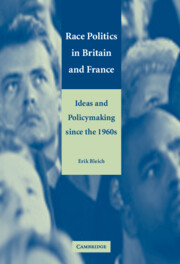Book contents
- Frontmatter
- Contents
- Preface and Acknowledgments
- Abbreviations and Acronyms
- Introduction
- 1 Perspectives on Comparative Public Policymaking: The Place of Frames
- 2 The Birth of British Race Institutions: 1945 to the 1965 Race Relations Act
- 3 Round Two: 1965 to the 1968 Race Relations Act
- 4 From 1968 to the 1976 Race Relations Act and Beyond
- 5 The Origins of French Antiracism Institutions: 1945 to the 1972 Law
- 6 The Struggle Continued: Antiracism from 1972 to the 1990 Gayssot Law and Beyond
- 7 Race Frames and Race Policymaking in Britain and France
- 8 Race, Racism, and Integration in Europe: Recent Developments, Options, and Trade-offs
- References
- Index
7 - Race Frames and Race Policymaking in Britain and France
Published online by Cambridge University Press: 26 December 2009
- Frontmatter
- Contents
- Preface and Acknowledgments
- Abbreviations and Acronyms
- Introduction
- 1 Perspectives on Comparative Public Policymaking: The Place of Frames
- 2 The Birth of British Race Institutions: 1945 to the 1965 Race Relations Act
- 3 Round Two: 1965 to the 1968 Race Relations Act
- 4 From 1968 to the 1976 Race Relations Act and Beyond
- 5 The Origins of French Antiracism Institutions: 1945 to the 1972 Law
- 6 The Struggle Continued: Antiracism from 1972 to the 1990 Gayssot Law and Beyond
- 7 Race Frames and Race Policymaking in Britain and France
- 8 Race, Racism, and Integration in Europe: Recent Developments, Options, and Trade-offs
- References
- Index
Summary
British and French race policies have evolved from their fragmentary postwar form into relatively well-developed institutions today. They have not, however, proceeded smoothly, nor have they followed identical paths. Multiple subplots and unexpected twists and turns have marked the history of race policies in these two countries, from Labour's about-face on immigration policies in the 1960s to France's shifting rules that let Parliament place antiracism on the official agenda in 1990. Moreover, in spite of similarities in numbers and percentages of ethnic minorities, each country struck out in a substantially different race policy direction. Closely examining the historical record has unveiled details about how and why leaders in each country chose their race relations and antiracism structures.
Tracking the evolution of race policies in Britain and France also makes it possible to examine and to assess theoretical approaches to the study of comparative public policymaking. Chapter 1 outlined the power-interest, problem-solving, and institutional perspectives on policymaking, and suggested that each served to illuminate the policymaking process. It also focused on frames, arguing that mainstream views of policymaking downplayed the role of such ideational variables in accounts of policy choices. Chapters 2 through 6 drew on these theoretical schools of thought to help analyze the construction of race institutions in Britain and France. This chapter, in turn, uses the empirical material to evaluate the theoretical perspectives themselves, with special emphasis placed on the role of frames in policy analysis.
- Type
- Chapter
- Information
- Race Politics in Britain and FranceIdeas and Policymaking since the 1960s, pp. 168 - 195Publisher: Cambridge University PressPrint publication year: 2003
- 1
- Cited by

